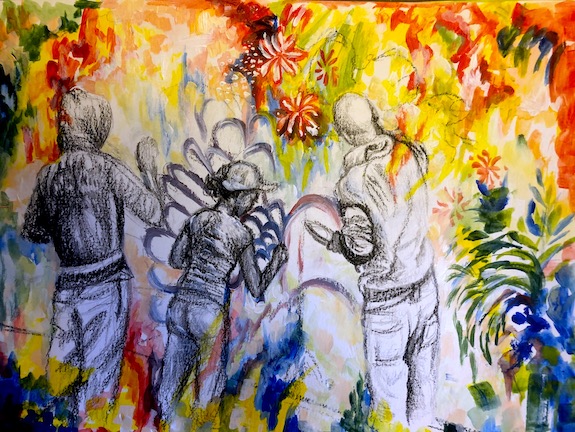Recherche artistique et formation des enseignants en arts : susciter l’intuition par le biais d’un montage de la mémoire des lieux
Contenu principal de l'article
Résumé
J’aborde dans cet article la recherche menée sur l’émergence d’une attitude intuitive au regard de la quête artistique des futurs enseignants vis-à-vis leurs anciens espaces scolaires et la conceptualisation du temps sous forme de montage pour introduire de nouvelles modalités pédagogiques en matière de formation des enseignants. Par la réalisation de films, les participants deviennent des nomades qui réagissent de manière physique et esthétique, à leur perception affective de leur mémoire en place. Ce faisant, le souvenir individualisé de la perception ordinaire de leurs études émerge, altérant le discours remémoré sur les motifs derrière leur volonté d’enseigner. Cela dénote l’importance de la pratique artistique au niveau des pratiques pédagogiques de la formation des enseignants et la valeur de l’apprentissage à travers l’expérience même plutôt que tirée de l’expérience.
Téléchargements
Renseignements sur l'article

Cette œuvre est protégée sous licence Creative Commons Attribution - Partage dans les Mêmes Conditions 4.0 International.
The copyright notice is CC BY SA.
This license lets others remix, tweak, and build upon your work even for commercial purposes, as long as they credit you and license their new creations under the identical terms. All new works based on yours will carry the same license. Thus any derivatives will also allow commercial use. For example, if someone translates your article into French, the French version of the article will also have to be shared under a CC BY SA license.
Références
Britzman, D. (2003). Practice makes practice: A critical study of learning to teach. Albany, NY: State University of New York Press.
Bullock, A. L., & Gailbraith, L. (1992). Images of art teaching: Comparing the beliefs and practices of two secondary art teachers. Studies in Art Education, 33(2), 86–97.
Butler, D. (2005). Giving an account of oneself. New York, NY: Fordham University Press.
Carter, K. (1993). The place of story in the study of teaching and teacher education. Educational Researcher, 22(1), 5–12, 18.
Clandinin, D. J. (1985). Personal practical knowledge: A study of teachers’ classroom images. Curriculum Inquiry, 15(4), 361–385.
Connelly, M. F., & Clandinin D.J. (1990). Stories of experience and narrative inquiry. Educational Researcher, 19(5) 2–14.
Deleuze, G. (1991). Bergsonism (H. Tomlinson & B. Habberjam, Trans.). New York, NY: Zone Books.
Deleuze, G., & Guattari, F. (1986). Kafka: Toward a minor literature (D. Polan, Trans.). Minneapolis, MN: University of Minnesota Press.
Deleuze, G., &. Guattari, F. (1987). A thousand plateaus: Capitalism and schizophrenia (B. Massumi, Trans.). Minneapolis, MN: University of Minnesota Press.
Dewey, J. (1934). Art as experience. New York, NY: Berkley Publishing Group.
Garoian, C. R. (2001). Performing the museum. Studies in Art Education, 42(3), 234-248.
Garoian, C. R. (2008). Verge of collapse: The pro/thesis of art research. Studies in Art Education, 49(3), 176–188.
Garoian, C. R. (2010). Drawing blinds: Art practice as prosthetic visuality. Studies in Art Education, 51(2), 218–234.
Garoian, C. R. (2013). The prosthetic pedagogy of art: Embodied research and practice. New York, NY: SUNY Press.
Gess-Newsome, J., Southerland, S.A., Johnston, A., & Woodbury, S. (2003). Educational reform, personal practical theories, and dissatisfaction: The anatomy of change in college science teaching. American Educational Research Journal, 40(3), 731–767.
Grauer, K. (1998). Beliefs of preservice teachers toward art education. Studies in Art Education, 39(4), 350–370.
Irwin, R. L. (2006). Walking to create an aesthetic and spiritual currere. Visual Arts Research 32(1), 75–82.
Irwin, R. L., & O’Donoghue, D. (2012). Encountering pedagogy through relational art practices. International Journal of Art and Design Education, 31(3), 222–236.
Jackson, A. Y., & Mazzei, L. A. (2012). Thinking with theory in qualitative research. London, UK: Routledge.
Kennedy, B. M. (2004). Deleuze and cinema: The aesthetics of sensation. Edinburgh, UK: Edinburgh University Press.
Massumi, B. (2002). Parables for the virtual: Movement, affect, sensation. Durham, NC: Duke University Press.
Munby, H. (1982). The place of teachers’ beliefs in research on teacher thinking and decision making, and an alternative methodology. Instructional Science, 11(3), 201–225.
Munby, H. (1984). A qualitative approach to the study of a teacher’s beliefs. Journal of Research in Science Teaching, 21(1), 27–38.
Nespor, J. (1987). The role of beliefs in the practice of teaching. Journal of Curriculum Studies, 19(4), 317–328.
O’Donoghue, D. (2007). “James always hangs out here”: Making space for place in studying masculinities at school. Visual Studies, 22(1), 63–73.
O’Sullivan, S. (2006). Art encounters Deleuze and Guattari: Thought beyond representation. New York, NY: Palgrave Macmillan.
Pajares, M. F. (1992). Teachers’ beliefs and educational research: Cleaning up a messy construct. Review of Educational Research, 62(3), 307–332.
Phelan, A. M. (2005). A fall from (someone else’s) certainty: Recovering practical wisdom in teacher education. Canadian Journal of Education, 28(3), 339–358.
Raudenbush, S. W., Rowan, B., & Cheong, Y. F. (1992). Contextual effects on the self-perceived efficacy of high school teachers. Sociology of Education, 65(2), 150–167.
Ricoeur, P. (1992). Oneself as another (K. Blamey, Trans.). Chicago, IL: University of Chicago Press.
Springgay, S. (2011). “The Chinatown Foray” as sensational pedagogy. Curriculum Inquiry, 41(5), 636–656.
Sullivan, G. (2010). Art practice as research: Inquiry in visual arts. Los Angeles, CA: Sage.

